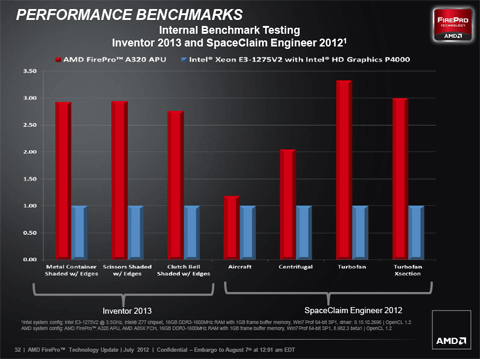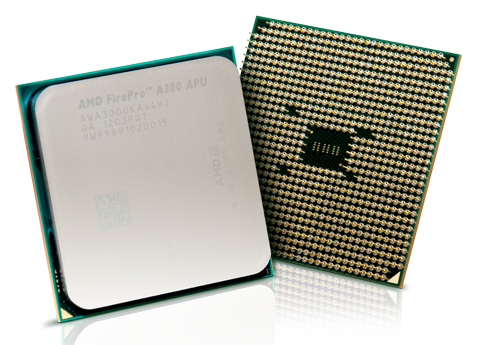
AMD FirePro A300 Series features an AMD FirePro GPU and an AMD ‘Piledriver’ x86 CPU on the same chip.
In addition to introducing a whole new family of FirePro professional graphics cards, AMD has set its sights on the entry-level workstation market with the launch of an Accelerated Processing Unit (APU) that combines a CPU and professional 3D GPU on a single chip.
The AMD FirePro A300 Series features an AMD FirePro GPU with 2GB DDR3 memory and an AMD ‘Piledriver’ x86 CPU. Just like AMD’s PCI Express FirePro graphics cards, the APU is certified to run many of the leading 3D CAD/CAM/CAE applications.
AMD’s APU sits flush on the motherboard, just like a standard CPU, so there is no need for an add-in PCI Express graphics card. This means lower cost and potential for some truly compact desktop workstations. Lower power consumption also means there is scope for mobile workstations and professional 3D tablets.
AMD is not the first chip-maker to offer a professional-level integrated CPU/GPU – Intel’s Xeon E3-1200v2 chip family already includes an Intel HD Graphics P4000 GPU. However, AMD points out that Intel’s GPU doesn’t offer the same level of ISV certification nor the same levels of 3D performance, which it backs up with some CAD benchmark data.

AMD FirePro A320 APU compared to Intel Xeon E3-1275V2 with Intel HD Graphics P4000
Putting the AMD FirePro A300 Series head to head with more established entry-level GPUs, AMD also claims that its new APU offers more powerful graphics performance than Nvidia’s current entry-level discrete board, the Quadro 600. AMD also highlights the APU’s potential for accelerating OpenCL-enabled applications, which can use a combination of CPU and GPU.
Of course, the big draw of the AMD FirePro A300 Series is likely to be cost. While prices were not disclosed, the all-in-one chip will almost certainly be cheaper than a traditional CPU / PCI Express GPU combination and will probably come in below Intel’s Xeon E3-1200v2. This could make a sub £500 desktop workstation, powerful enough for entry-level 3D CAD, a real possibility.
The major challenge for AMD will be to get this product to market. To make an impact in the workstation market it will need to work on the major OEMs. Dell, HP, Lenovo and Fujitsu all have very close relationships with Intel so AMD will need to put forward a compelling argument for its APU.
To put this in perspective, AMD last enjoyed big success with workstation CPUs in the early 2000s when its Opteron chip was adopted by HP and Siemens. However, at the time, AMD Opteron offered a significant performance benefit over Intel’s CPUs. With the AMD FirePro A300 Series it will be more about price / performance.
Size could also be an attractive proposition. AMD’s APU could be used to create a truly compact workstation, even smaller than the Small Form Factor (SFF) Lenovo ThinkStation E31 and HP Z220, which currently rely on Nvidia’s low-profile Quadro 600 graphics card.
While the OEMs evaluate the technology, it’s likely that a specialist workstation manufacturer will be first to bring the AMD FirePro A300 Series to market. AMD confirmed it is already talking to manufacturers in the UK.
Of course, another advantage of the AMD FirePro A300 Series is its low power consumption, which starts at 65W for an entry-level model. This should also make the APU an interesting technology for entry-level mobile workstations and professional 3D tablets, where extending battery life is a continual challenge.
Look out for a review soon.






